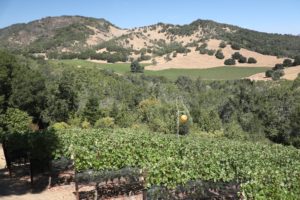

 Black Cordon was founded by the husband wife team of David and Karen Dunphy with their first vintage from 2007. Both are from Minnesota. David has been a self-admitted “wine geek” since the age of 18. His wine journey began with French wines, followed by Spanish bottlings and then wines from Italy. His epiphany wine was a 1969 La Tache he acquired for $12.
Black Cordon was founded by the husband wife team of David and Karen Dunphy with their first vintage from 2007. Both are from Minnesota. David has been a self-admitted “wine geek” since the age of 18. His wine journey began with French wines, followed by Spanish bottlings and then wines from Italy. His epiphany wine was a 1969 La Tache he acquired for $12.
He was introduced to Napa Valley in 1978 after hearing about the Judgment of Paris tasting held in Paris two years prior. While living in Minnesota he and Karen would visit Napa 2-3 times per year. David recalls this period in Napa’s wine making history as a time when there were far fewer wineries in the valley and very few tasting rooms. He met and became friends with some of Napa’s old timers including Charlie Wagner at Caymus, Justin Meyer at Silver Oak and Cathy Corison when she was still at Etude and prior to starting Corison Winery. David remembers tasting with them at their homes or in their kitchens, reaching a level of tasting personalized with the owners far beyond what one typically finds at a tasting room these days.
He recalls one tasting in particular; in 1979 he was enjoying wine in Charlie Wagner’s kitchen when Charlie invited him to come to his cellar to try a special barrel of wine. David vividly remembers Charlie walked him over to what was labeled, Barrel #5. This wine stood out from the other barrel samples they tried; Charlie informed David he was planning on bottling this individually and calling it his special selection, a coveted barrel selection the Wagner family first started with the 1975 vintage. David asked for two cases of this wine; Charlie bottled it separately for him.
And during another trip to Napa Valley in 1985, David and Karen planned to stay at the Best Western in Yountville. But then while exploring the valley they saw the new cottages’ in the hills near St. Helena. They drove onto the property; the manager at the time came out and greeted them. He mentioned the new cottages were not yet open to the public but that they were in a two week trial period with staff. He told them to come back later, but as they were pulling out of the parking lot, the manager ran out and had changed his mind. He offered them a cottage; so they stayed. David and Karen married in at Auberge du Soleil in 1987 (the properties’ first hosted wedding); they continued to visit Napa Valley each year until they purchased their first property here in 2004.
Today David and Karen own 15 vineyard acres in Napa Valley. They have selectively purchased small vineyard sites ranging from mountain top to valley floor from Howell Mountain to Yountville to Coombsville. The three-acre vineyard next to their home is perched on a hillside straddling both Mt. Veeder and the Oak Knoll District; parts of their vineyard are within both sub appellations. This part of Redwood Road along the “Dry Creek Corridor” as David calls it, is home to many small family-owned vineyards with a number of them making limited production wines commercially.
Despite being only an approximately 15 minute drive from downtown Napa, this is a little visited part of Napa Valley because there are no tasting rooms here; the few small wineries that are here are not open to the public.
The name Black Cordon came about somewhat accidentally. One day David mixed up his cordon trellising terms and announced to his family and vineyard guys they were going to trellis all their vineyards in a “black cordon” style – when in actuality this term refers to the color of the vines when they are wet.
In 2012 David and Karen took over all the vineyard management decisions. Vineyards have become their passion; they both work among the vines alongside their crew in each of the vineyards they own in the valley (some 15 planted acres). As David says in regards to his red wines, “I don’t grow grapes, I grow skins”. And when you start to think about that statement, it starts to make sense. Skins for red wine varieties are where the colors, flavors and tannins come from.
Balance in their vineyard equates to balance in their wines. Their estate vineyard is the definition of precision farming including careful irrigation (several rows required a more precise watering regiment so additional tubing was brought in just for this tiny section of the vineyard), birdlife mitigation including using lasers and canopy management. The amount of hours worked by hand among the vines is impressive including trimming clusters so they are all similar sized and ensuring shoots are in parallel with one another. And at the end of every year David walks the estate vineyard identifying any vines that show signs of virus. They are rogued (removed) and new vines are planted in their place. This careful management of virus has resulted in a very low number of vines removed each year.
Grapes are used from both their mountain & hillside vineyards to bring a complexity and intensity to the wine complemented by valley fruit from their Yountville and Coombsville vineyards to “calm” as David says, “the structure and tannins of their hillside fruit”. They do not follow a wine making formula each year, instead they work with what mother nature gives them and make blending decisions accordingly.
Harvest decisions are based on individual rows, not the entire vineyard and usually lasts three to four weeks. They harvest their grapes as they ripen rather than needing to harvest a certain volume for tank size. Their ferments are in open-top fermentation bins; they prefer to pick slightly riper letting some of the alcohol ‘blow-off’ or evaporate. Color, flavor and tannin extraction are carefully managed. Temperature plays an important role in their fermentation and is determined by each vintage based on a variety of factors including thickness of skins.
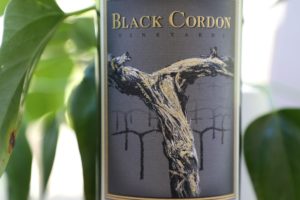
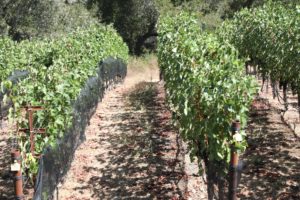 After the wines are dry, they press off into barrels. During their two year élevage, they evaluate regularly based on taste. There is no blending between barrels until prior to bottling. At the end of two years, they evaluate each barrel based on its own merit; some of the barrels do not make the final cut.
After the wines are dry, they press off into barrels. During their two year élevage, they evaluate regularly based on taste. There is no blending between barrels until prior to bottling. At the end of two years, they evaluate each barrel based on its own merit; some of the barrels do not make the final cut.
Paul Hobbs was the founding winemaker for Black Cordon; today Paul’s former lead winemaker for all of his California projects, Julian Gonzalez does all of the wine making work for Black Cordon and their accompanying brand, Sixteen by Twenty. David’s first meeting with Paul was by chance; David’s vineyard manager at the time had a meeting with Paul and invited David to join him at the Red Hen Cantina, a popular Mexican bar that was sandwiched between several hotels in north Napa.
David and Paul hit it off immediately, so David showed him a list of potential winemakers he was interested in hiring. Paul had worked with all the winemakers before and gave his feedback, but then stopped and said, “how about I make your wine”. David was taken back as the thought of Paul offering this had not crossed his mind. When asked why he was interested in making his wine, Paul told him it was because of two reasons; he liked David’s passion and strong interest in learning more about viticulture and he missed working with a small producer.
David considers his Coombsville vineyard source, his favorite among his diverse portfolio of sites. Before he and Paul owned vineyards, they would share vineyard sites with each other and would source and share blocks grapes from within the vineyards. Over this period they discovered a vineyard in Coombsville which David felt would rival the best vineyards in California. And they also found a vineyard in Sonoma County which was particular exceptional for Chardonnay. Ultimately Hobbs purchased both sites, Goldrock on Sonoma Coast and the Nathan Coombs Vineyard in Coombsville. Every year David catches up with Paul before harvest and always ends his conversation with two requests, “do you want to go golfing and can you sell me some grapes from Goldrock and Nathan Coombs. Paul always turned down both requests. But eventually he agreed to sell grapes from both sites to David and took the conversation a step further. He told David he is proud of what he has accomplished with Black Cordon and Sixteen by Twenty and he encouraged him to vineyard designate the wines from both properties. So he does.
These wines are balanced, are never released until they are ready and are always built with age in mind, regardless of the variety.
Select Wines
Black Cordon
Chardonnay
David purchases premium Chardonnay in Sonoma County from the Russian River appellation as well as Sonoma Coast; he prefers Chardonnay grown close to the cooler coastline. A number of vintners were buying from the same vineyards and all making single vineyard Chardonnay. Instead of making a single vineyard designate, David decided to combine grapes from some of the best vineyards in these regions to make a Chardonnay from multiple premium vineyards.
Paul pioneered a way to have the secondary fermentation (malolactic) occur at the same time as the primary alcoholic fermentation. Diacetyl, a compound created during the secondary fermentation that causes the perception of a buttery notes in a wine” is actually metabolized based on what occurs during these simultaneous fermentations. All indigenous yeasts are used for primary fermentation. In some cases, their Chardonnay fermentation moves along extremely slowly – up to 8 months. According to David, his Chardonnays start hitting a sweet spot between 5 to 7 years.
The 2022 Black Cordon Reserve Chardonnay Sonoma Coast is pale gold in color; the bouquet is noteworthy for what it doesn’t have. By this we mean no heavy oak and no over ripeness. Not boring. Rather: elegant & compelling. Its scents include golden apples, walnut skin, thyme, honeycomb, comise pear, a light note of butter, and perfectly ripe apricot. Bright, balanced and refreshing, the palate is singing soprano three years post vintage. Its flavors include apricot, white peach, white nectarine, a light note of pineapple, comise pear, pineapple guava and lychee (a flavor we rarely associate with California Chardonnay). Finishes bright, dry and dare we say juicy; it is thoroughly refreshing. Highly worth seeking out, this bottling will hold its own against any of California’s premium producers of this variety. We are going to go off the perceived pairing when it comes to Chardonnay, because this wine lends itself to such a bold statement. We would love to pair this with a thick ribeye grilled steak. Its listed ABV is 14.2%.
Cabernet Sauvignon
The 2018 Black Cordon Cabernet Sauvignon, Napa Valley. Like all their Cabernet Sauvignon this bottling does not lack in color; it is deep ruby and opaque. This wine smells like petrichor, slate rock, dark chocolate, blackberry, dark raspberry, Himalayan mulberry and blackberry. The palate offers offers an intensity of darker fruits but without the intensity of texture. Its flavors include dark blackberry, dark raspberry, Santa Rosa plum and boysenberry. The finish lingers savory and spicy including pepper and assorted smoked herbs including sage. Seven years post vintage the tannins are still firmly gripping with a dusty and chalky character, ultimately outpacing the fruit on the finish. A minerally ferrous character does not quite cross into the territory of being sanguine. It needed time in bottle for the tannins to be tamed; David sold out of all his 2019 wines before this wine was even released. He calls this his Cab lovers Cabernet. Grapes from all four mountain sites were blended into this wine including from Mt. George, Atlas peak, Howell Mountain and Mount Veeder.
The 2016 Black Cordon Cabernet Sauvignon, Howell Mountain is deep ruby and opaque. The distinctive bouquet offers aromas of black cherry, dark currant, dark plum, dark chocolate and dried rose petals. This wine is dark fruited, bright and balanced. Its flavors include dark plum, blackberry, boysenberry and dark cherry. We love this wine’s texture; the broadly distributed and dense tannins feel spherical – time has been kind to their overall feel. There is some chalky weight here but this attribute is balanced nicely by the bright acidity and intensity of flavor. The tannins linger with a polished and supple character, seamlessly integrated in tandem with the fruit on the finish. This is another example of how well the Black Cordon wines age.

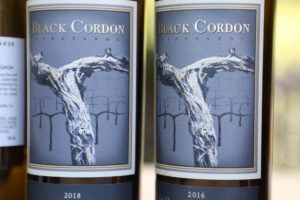
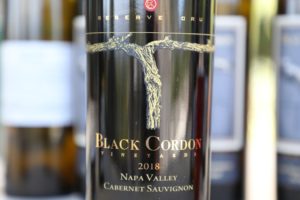 The 2016 Black Cordon Cabernet Sauvignon Mt. Veeder is deep ruby and opaque; this wine initially shows a bit more brooding than the 2016 Howell Mountain bottling. Its scents include dark cherry, boysenberry, dark raspberry, mocha, dark cocoa powder and some lighter but accompanying notes of dried dark tea leaves. Nine years post vintage, this wine still smells primary with lots of energy and aromatic life. Give it time to open; the bouquet evolves wonderfully, with its fruit really starting to shine with some oxygen. On the palate there are red and dark fruited flavors including plum, cherry, boysenberry, dark plums and a finishing note of dried herbs. Intensely flavored. In part, and a big part, the vibrant acidity has carried this wine comfortably nearly a decade since its vintage date. In terms of texture at this age, one adjective rises to the top, plush. The tannins outpace the fruit on the finish with a light dusty character. Regardless of vintage, David always noticed a cherry aroma and flavor from wines from this property. Hobbs identified the exact variety of cherry during one of his trips to France; it was the Montmorency cherry, a cultivar of the sour cherry.
The 2016 Black Cordon Cabernet Sauvignon Mt. Veeder is deep ruby and opaque; this wine initially shows a bit more brooding than the 2016 Howell Mountain bottling. Its scents include dark cherry, boysenberry, dark raspberry, mocha, dark cocoa powder and some lighter but accompanying notes of dried dark tea leaves. Nine years post vintage, this wine still smells primary with lots of energy and aromatic life. Give it time to open; the bouquet evolves wonderfully, with its fruit really starting to shine with some oxygen. On the palate there are red and dark fruited flavors including plum, cherry, boysenberry, dark plums and a finishing note of dried herbs. Intensely flavored. In part, and a big part, the vibrant acidity has carried this wine comfortably nearly a decade since its vintage date. In terms of texture at this age, one adjective rises to the top, plush. The tannins outpace the fruit on the finish with a light dusty character. Regardless of vintage, David always noticed a cherry aroma and flavor from wines from this property. Hobbs identified the exact variety of cherry during one of his trips to France; it was the Montmorency cherry, a cultivar of the sour cherry.
David describes their 2010 Black Cordon Cabernet Sauvignon as a long-lived vintage; we can see why after trying this wine. It is a dark wine; the nose draws one in with its “dessert in a glass” characteristics including baking spices, cherry pie, floral scents (violets) and hints of dark chocolate as the wine breathes. This wine has remarkable depth and structure and still drinks young despite being 4.5 years old at the time of our tasting. The oak is integrated well with the long-lasting fruit tannins sporting a bold, long-lasting and grippy character.
The 2012 Black Cordon Cabernet Sauvignon is dark purple in the glass and soon reveals elegant floral notes on the bouquet as well as cinnamon spice, blueberry and mocha. The bouquet is as complex as on the palate. It is surprisingly soft initially on the entry but then words such as density, complexity and richness of flavor quickly come to mind when describing the overall cadence of this wine. It features both black and blue fruits, notes of old cedar box, coffee grinds and chewy dense tannins (not harsh) which linger for quite some time.
The 2012 Black Cordon Reserve Cru Cabernet Sauvignon is a barrel selection (3 barrels). Unlike the other reds we tried this is a single vineyard, single varietal bottling from Coombsville. The dark fruit showing on the bouquet continues on the palate with generous layers of mouth filling fruit including black currant, black licorice and dark cherry. “Stuffed” is a word David mentioned to us when describing this wine. It is dense and well extracted like the younger vintage we tried. The tannins are earthy and slightly chalky. The intensity of flavors lingers, and when you think the finish has been completed, it continues even longer showcasing both flavor and texture. This wine is only produced when the quality of certain barrels meets their exacting expectations. For instance it has only been bottled in 2010, 2012 and 2018.
Sixteen by Twenty
Black Cordon also produces another label called Sixteen by Twenty, a companion label to Black Cordon. Both brands were founded simultaneously without any intent of creating a ‘second label’. The name Sixteen by Twenty refers to the most common canvas size used by artists. This size generally is accepted as an ideal dimension for providing the perfect balance. Making the segue to growing grapes and wine making, David chose this name to represent the same type of balance he strives to create among each vine in the vineyard as well as in the winery.
The focus of these wines is to keep production very small and to have the flexibility to take advantage of sourcing from a number of vineyards from year to year both in Napa Valley and Sonoma. Each vintage these wines are created to overdeliver on quality to price point.
David remembers their first commercial vintage was only 15 cases. Out of more than 1,200 Napa Valley based wineries or producers we have visited with; this certainly one of the small commercial productions. Once this particular wine had some bottle age, he and Karen put all 15 cases in their truck and drove around Napa Valley in the hopes of selling some. Upon arriving at the Wine Garage wine shop in Calistoga (today home to Tank Garage Winery), they were pleasantly surprised when the owner purchased a significant amount of their total production – he took 6 cases. The next year they produced 56 cases and have grown since.
Sixteen by Twenty produces three wines, a Sonoma Coast Chardonnay, Pinot Noir and a Napa Valley Cabernet Sauvignon.
The 2021 Sixteen by Twenty Chardonnay, Sonoma Coast is medium gold in color; the bouquet smells fresh and lively with aromas of apricot, golden apples, red delicious apple skin, pineapple, yellow nectarine, and a hint of pina colada. As it evolves it opens to a light note of vanilla. Bright and intensely flavored, the palate offers flavors of pineapple, golden delicious apples, apricots, golden plums, white peaches, yellow nectarines, an orange zest and papaya. The fleshy and creamy textured palate offers some weight, but its feel is buoyed high by its bright and racy acidity. This wine finishes juicy, vivacious and filled with energy. It is still showing its youthful characteristics 4 years post vintage and has plenty of life ahead of it with the proper cellar care. Compared to the Black Cordon Sonoma Coast bottling, which is more restrained, this bottling a more energetic and intense expression of the varietal.
The 2023 Sixteen by Twenty Pinot Noir is pale ruby in color; the floral attributes that are so appreciated with elegant bottlings of this wine are clearly evident on the bouquet. Its aromas include dried rose petals, lilacs, lavender and red fruits including raspberry and strawberry. And as the wine evolves it opens to sweeter baking spices including cardamom, cinnamon and cloves. On the palate there are flavors of raspberry, red cherry and currant. And the baking spices on the bouquet are also expressed on the palate. Finish with a note of cloves and cinnamon. The tannins sport a light and persistent grip with a light gravelly character. Balanced and bright. Juicy. Texture should always be a part of California Pinot Noir, but sadly, all to often it is bled out by over ripeness.
Pinot Noir from Anderson Valley was produced through the 2014 vintage until the quality of grapes became compromised by red blotch disease. So David pivoted to Sonoma Coast for this variety for Black Cordon. But as of 2024 production has transitioned back to Anderson Valley for Black Cordon and Pinot Noir for Sixteen by Twenty is bottled from Sonoma Coast.
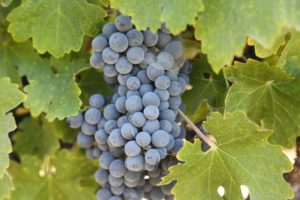 The 2017 Sixteen by Twenty Cabernet Sauvignon Napa Valley is 100% varietal. This wine is deep ruby and nearly opaque; the nose is focused on its core fruit with the oak providing a light and complementary influence. The grapes for this wine are located in cooler spots of Napa Valley, which consistently result in darker aromatics and fruit flavors. The bouquet smells like cherry, dark raspberry, blackberry, red licorice and dark cocoa powder, accompanied by a ferrous minerally character. This wine is highly approachable at this age, 8 years post vintage. The palate tastes blackberry, dark plum, dark cherry, boysenberry and Persian mulberry and lingers with a note of cocoa powder. The minerally character also shows on the palate. The tannins are ripe, resolved and fully rounded. They linger with a light dusty character. This wine is showing in a sweet spot at this age.
The 2017 Sixteen by Twenty Cabernet Sauvignon Napa Valley is 100% varietal. This wine is deep ruby and nearly opaque; the nose is focused on its core fruit with the oak providing a light and complementary influence. The grapes for this wine are located in cooler spots of Napa Valley, which consistently result in darker aromatics and fruit flavors. The bouquet smells like cherry, dark raspberry, blackberry, red licorice and dark cocoa powder, accompanied by a ferrous minerally character. This wine is highly approachable at this age, 8 years post vintage. The palate tastes blackberry, dark plum, dark cherry, boysenberry and Persian mulberry and lingers with a note of cocoa powder. The minerally character also shows on the palate. The tannins are ripe, resolved and fully rounded. They linger with a light dusty character. This wine is showing in a sweet spot at this age.
—
Between both Black Cordon and Sixteen by Twenty Wines, their production is usually around 3,000 cases annually. Each wine is typically only several hundred cases. The wines are selectively distributed in 10+ states and parts of Japan. And they are available at a number of premium restaurants in Napa Valley. Word of mouth has been an important sales channel. For more information and to purchase wines (each bottling is sold exclusively in a 6 or 12 pack), visit: www.blackcordon.com

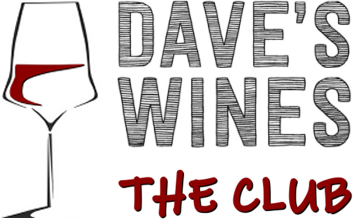




I’m interested incoming to your vineyard and tasting Black Cordon wines.
I’ll share my stories about sharing wines with Bonny and Justin, Gil Nickel, and Andre Teillichef
(SP), Robert Mondavi and the Baron,
I was at the Firehouse Restaurant in Sacramento for more than 40 years. I’m still assisting Dan in wine buying. Please look at our website
http://www.firehouseoldsac.com
We have one of the most wonderful cellars in California, maybe usa,
I would love to have Black Cordon ….
Mario – thanks for reaching out. What a great selection of wines at Firehouse. I’ll send a note to David as well. I would love to hear your stories in regards to Bonny and Justin Meyer in particular. Hope to see you at Silver Oak’s 50th party this Saturday?
I’m up to 1,177 Napa Valley based wineries or brands personally visited with, tasted the wines and extensively written about. I’m not sure anyone else has amassed such a collection of Napa Valley winery content.
There are some very special limited production brands I work with. Would love to talk to you about getting a couple of bottlings into your extensive menu.
~ Dave